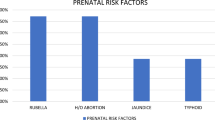Abstract
Objectives
To identify the prevalence of GJB2 (Cx 26)and GJB6 (Cx 30) mutations in hearing impaired individuals from Western and South India.
Study design
Cross-sectional study.
Methods
Families with hearing impaired individuals (prelingual, non-syndromic, sensori-neural hearing loss) were enrolled and genomic DNA was extracted. Primers were designed for amplifying the coding and non-coding exons including flanking splice sites of the Cx 26 gene. Probands heterozygous or negative for Cx 26 mutations were further analyzed for the 342Kb deletion encompassing D13S1830 microsatellite marker on Cx 30.
Results
Two hundred and eighty-eight patients were enrolled in the study and 116 (40.3%) were diagnosed to have mutations in the coding exon 2 of Cx 26 gene. Fifty-four (18.8%) probands were found to have mutations in both the alleles while the remaining 62 (21.5%) were heterozygous for Cx 26 mutations. W24X, and W77X were the common mutations identified. The prevalence of familial deafness was similar in both consanguineous and non-consanguineous families (33% and 34.9% respectively). Mutations in the non-coding exon 1 and intron 1 as well as the 342 kb deletion involving D13S1830 marker on Cx 30 were ruled out in two hundred and thirty-four deaf individuals carrying none or only one mutation in the exon 2 of Cx 26 gene.
Conclusion
Cx30 mutations do not contribute to the autosomal recessive non-syndromic hearing loss (NSHL) in the Indian population. Homozygous Cx26 mutations account only for about 1/5th (18.8%) of autosomal recessive non-syndromic hearing implying the need to explore other contributory loci.
Similar content being viewed by others
References
Petit C, Levilliers J, Hardelin JP (2001) Molecular genetics of hearing loss. Ann Rev Genet 35:589–646
Mani RS, Ganapathy A, Jalvi R, Srisailapathy CRS, Malhotra V, Chadha S, Agarwal A, et al. (2009) Functional consequences of novel connexin 26 mutations associated with hereditary hearing loss. Eur J Hum Genet 17(4): 502–509
Ghosh M, Vijaya R, Kabra M (2004) Genetics of deafness in India. Indian J Pediatr 71(6):531–533
Wu BL, Kenna M, Lip V, Irons M, Platt O (2003) Use of a multiplex PCR/Sequencing strategy to detect both Connexin 30 (GJB6) 342 kb deletion and Connexin 26 (GJB2) mutations in cases of childhood deafness. Am J Hum Genet 121(2):102–108
del Castillo I, Moreno-Pelayo MA, Del Castillo FJ, Brownstein Z, Marlin S, Adina Q, Cockburn DJ, et al. (2003) Prevalence and evolutionary origins of the del(GJB6-D13S1830) mutation in the DFNB1 locus in hearing-impaired subjects: A multicenter study. Am J Hum Genet 73(6):1452–1458
Yum SW, Zhang J, Valiunas V, Kanaporis G, Brink PR, White TW, Scherer SS (2007) Human connexin26 and connexin30 form functional heteromeric and heterotypic channels. Am J Physiol Cell Physiol 293(3):C1032–C1048
Rabionet R, Gasparini P, Estivill X (2000) Molecular genetics of hearing impairment due to mutations in gap junction genes encoding beta connexins. Hum Mutat 16(3):190–202
Bhalla S, Sharma R, Khandelwal G, Panda NK, Khullar M (2009) Low incidence of GJB2, GJB6 and mitochondrial DNA mutations in North Indian patients with non-syndromic hearing impairment. Biochem Biophys Res Commun [Epub ahead of print]
Gasparini P, Rabionet R, Barbujani G, Melchionda S, Petersen M, Brendum-Nielsen K, Metspalu A, et al. (2000) High carrier frequency of the 35delG deafness mutation in European populations. Genetic Analysis Consortium of GJB2 35delG. Eur J Hum Genet 8(1):19–23
Lerer I, Sagi M, Ben-Neriah Z, Wang T, Levi H, Abeliovich D (2001) A deletion mutation in GJB6 cooperating with a GJB2 mutation in trans in non-syndromic deafness: A novel founder mutation in Ashkenazi Jews. Hum Mutat 18(5):460
Abe S, Usami S, Shinkawa H, Kelley PM, Kimberling WJ (2000) Prevalent connexin 26 gene (GJB2) mutations in Japanese. J Med Genet 37(1):41–43
Alvarez A, del Castillo I, Villamar M, Aguirre LA, Gonzalez-Neira A, López-Nevot A, et al. (2005) High prevalence of the W24X mutation in the gene encoding connexin-26 (GJB2) in Spanish Romani (gypsies) with autosomal recessive non-syndromic hearing loss. Am J Med Genet 137(3):255–258
Bouchaib Gazzaz, et al. (2005) Autosomal recessive and sporadic deafness in Morocco: High frequency of the 35delG GJB2 mutation and absence of the 342 kb GJB6 variant. Hear Res 210:80–84
Seeman P, Bendova O, Raskova D, et al. (2005) Double heterozygosity with mutations involving both the GJB2 and GJB6 genes is a possible, but very rare, cause of congenital deafness in the Czech population. Ann Hum Genet 69:9–14
RamShankar M, Girirajan S, Dagan O, Ravi Shankar HM, Jalvi R, Rangasayee R, Avraham KB, Anand A (2003) Contribution of connexin26 (GJB2) mutations and founder effect to non-syndromic hearing loss in India. J Med Genet 40(5):e68
Liu Y, Ke X, Qi Y, Li W, Zhu P (2002) Connexin26 gene (GJB2): Prevalence of mutations in the Chinese. J Hum Genet 47(12):688–690
Frei K, Ramsebner R, Lucas T, Baumgartner WD, Schoefer C, Wachtler FJ, Kirschhofer K (2004) Screening for monogenetic del(GJB6-D13S1830) and digenic del(GJB6-D13S1830)/GJB2 patterns of inheritance in deaf individuals from Eastern Austria. Hear Res 196(1–2):115–118
Santos RL, Wajid M, Pham TL, Hussan J, Ali G, Ahmad W, Leal SM (2005) Low prevalence of Connexin 26 (GJB2) variants in Pakistani families with autosomal recessive non-syndromic hearing impairment. Clin Genet 67(1):61–68
Najmabadi H, Nishimura C, Kahrizi K, Riazalhosseini Y, Malekpour M, Daneshi A, Farhadi M (2005) GJB2 mutations: Passage through Iran. Am J Med Genet 133A(2):132–137
Riazuddin S, Khan SN, Ahmed ZM, Ghosh M, Caution K, Nazli S, Kabra M (2006) Mutations in TRIOBP, which encodes a putative cytoskeletal-organizing protein, are associated with nonsyndromic recessive deafness. Am J Hum Genet 78(1):137–143
Author information
Authors and Affiliations
Corresponding author
Rights and permissions
About this article
Cite this article
Godbole, K., Hemavathi, J., Vaid, N. et al. Low prevalence of GJB2 mutations in non-syndromic hearing loss in Western India. Indian J Otolaryngol Head Neck Surg 62, 60–63 (2010). https://doi.org/10.1007/s12070-010-0009-5
Published:
Issue Date:
DOI: https://doi.org/10.1007/s12070-010-0009-5




